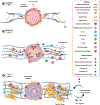Engineering Advanced In Vitro Models of Systemic Sclerosis for Drug Discovery and Development
- PMID: 33852183
- PMCID: PMC8717409
- DOI: 10.1002/adbi.202000168
Engineering Advanced In Vitro Models of Systemic Sclerosis for Drug Discovery and Development
Abstract
Systemic sclerosis (SSc) is a complex multisystem disease with the highest case-specific mortality among all autoimmune rheumatic diseases, yet without any available curative therapy. Therefore, the development of novel therapeutic antifibrotic strategies that effectively decrease skin and organ fibrosis is needed. Existing animal models are cost-intensive, laborious and do not recapitulate the full spectrum of the disease and thus commonly fail to predict human efficacy. Advanced in vitro models, which closely mimic critical aspects of the pathology, have emerged as valuable platforms to investigate novel pharmaceutical therapies for the treatment of SSc. This review focuses on recent advancements in the development of SSc in vitro models, sheds light onto biological (e.g., growth factors, cytokines, coculture systems), biochemical (e.g., hypoxia, reactive oxygen species) and biophysical (e.g., stiffness, topography, dimensionality) cues that have been utilized for the in vitro recapitulation of the SSc microenvironment, and highlights future perspectives for effective drug discovery and validation.
Keywords: 3D in vitro models; animal models; fibrosis; in vitro microenvironment; scleroderma; tissue engineering.
© 2021 The Authors. Advanced Biology published by Wiley-VCH GmbH.
Conflict of interest statement
Conflict of Interest
The authors declare no conflict of interest.
Figures





Similar articles
-
Animal models in systemic sclerosis: an update.Curr Opin Rheumatol. 2023 Nov 1;35(6):364-370. doi: 10.1097/BOR.0000000000000967. Epub 2023 Aug 21. Curr Opin Rheumatol. 2023. PMID: 37605874 Free PMC article. Review.
-
Paquinimod reduces skin fibrosis in tight skin 1 mice, an experimental model of systemic sclerosis.J Dermatol Sci. 2016 Jul;83(1):52-9. doi: 10.1016/j.jdermsci.2016.04.006. Epub 2016 Apr 19. J Dermatol Sci. 2016. PMID: 27156795
-
Systemic sclerosis.J Dermatol. 2018 Feb;45(2):128-138. doi: 10.1111/1346-8138.14153. Epub 2017 Dec 10. J Dermatol. 2018. PMID: 29226387 Review.
-
The Microbiome in Systemic Sclerosis: Pathophysiology and Therapeutic Potential.Int J Mol Sci. 2022 Dec 18;23(24):16154. doi: 10.3390/ijms232416154. Int J Mol Sci. 2022. PMID: 36555792 Free PMC article. Review.
-
Clinical Treatment Options in Scleroderma: Recommendations and Comprehensive Review.Clin Rev Allergy Immunol. 2022 Apr;62(2):273-291. doi: 10.1007/s12016-020-08831-4. Epub 2021 Jan 15. Clin Rev Allergy Immunol. 2022. PMID: 33449302 Review.
Cited by
-
Adapting the Scar-in-a-Jar to Skin Fibrosis and Screening Traditional and Contemporary Anti-Fibrotic Therapies.Front Bioeng Biotechnol. 2021 Oct 26;9:756399. doi: 10.3389/fbioe.2021.756399. eCollection 2021. Front Bioeng Biotechnol. 2021. PMID: 34765594 Free PMC article.
-
Fibroblasts and Endothelial Cells in Three-Dimensional Models: A New Tool for Addressing the Pathogenesis of Systemic Sclerosis as a Prototype of Fibrotic Vasculopathies.Int J Mol Sci. 2024 Feb 28;25(5):2780. doi: 10.3390/ijms25052780. Int J Mol Sci. 2024. PMID: 38474040 Free PMC article.
-
Cell Cultures as a Versatile Tool in the Research and Treatment of Autoimmune Connective Tissue Diseases.Cells. 2023 Oct 19;12(20):2489. doi: 10.3390/cells12202489. Cells. 2023. PMID: 37887333 Free PMC article. Review.
-
Harnessing organoid technology to model autoimmune pathways in rheumatological and inflammatory disorders.Naunyn Schmiedebergs Arch Pharmacol. 2025 Jul 15. doi: 10.1007/s00210-025-04387-2. Online ahead of print. Naunyn Schmiedebergs Arch Pharmacol. 2025. PMID: 40663155 Review.
-
3D Printed Multiphasic Scaffolds for Osteochondral Repair: Challenges and Opportunities.Int J Mol Sci. 2021 Nov 17;22(22):12420. doi: 10.3390/ijms222212420. Int J Mol Sci. 2021. PMID: 34830302 Free PMC article. Review.
References
Publication types
MeSH terms
Grants and funding
LinkOut - more resources
Full Text Sources
Other Literature Sources
Medical

